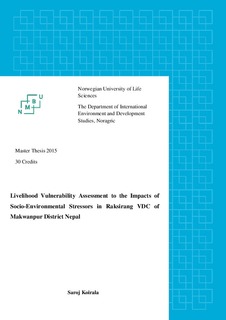| dc.description.abstract | This study was conducted to estimate the level of livelihood vulnerability (Livelihood
Vulnerability Index- LVI) for the Chepang community of Rakshirang Village Development
Committee of Makawanpur district in Nepal and compare the vulnerability level between
female-headed and male-headed households. This research has examined how local people at the study community perceive livelihood vulnerability and in what ways they think sustainable livelihood outcomes can be achieved at the community level.
Eighty (16.77%) out of 477 HHs of Raksirang VDC´s wards 8 and 9 were randomly selected for conducting a structured questionnaire survey together with unstructured in-depth interviews for data collection. The data was analyzed using the Sustainable Livelihood Framework (SLF) and Livelihood Vulnerability Index- LVI was calculated by using the pragmatic approach developed by Hahn et al. (2009).
The LVI for the studied community was found to be 0.5, which can be considered as a
moderate level of livelihood vulnerability in terms of socio-environmental stressors.
Households were most vulnerable in terms of financial capital (0.59), followed by social
(0.54), natural (0.53), human (0.40) and physical (0.44) capitals. The female-headed HHs
(0.53) were found to be slightly more vulnerable than male-headed HHs (0.47) in terms of
LVI. However, these slight differences were not testable statistically as the samples were
unequally represented.
Local people perceived their livelihood vulnerability as the product of poor infrastructures,
limited access to basic public services such as education and healthcare, restricted access to the forest based natural resources and inadequate knowledge and skills on income generating activities. Frequent flooding in Manahari River and landslides over the hills during monsoon season has added addition pressure on local livelihood. According to them, provision of efficient technology and skills in agriculture, transformation from subsistence farming, rightful access and sustainable exploitation of natural resources, physical infrastructures such as proper road, irrigation systems, suspension bridge over Manahari River and electricity supplies were essential elements for enhanced connectivity, sustainable growth and over all development of the community. | nb_NO |

